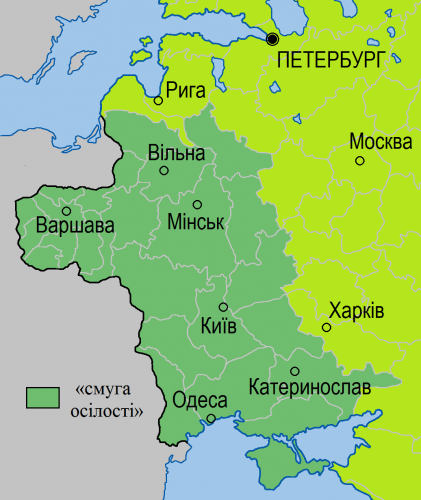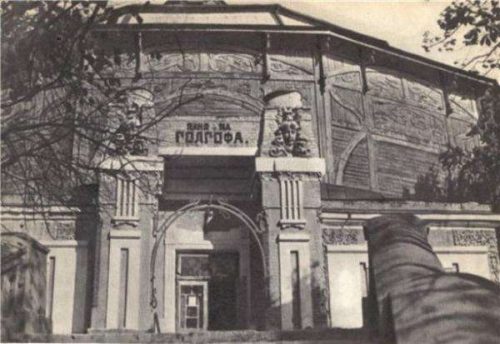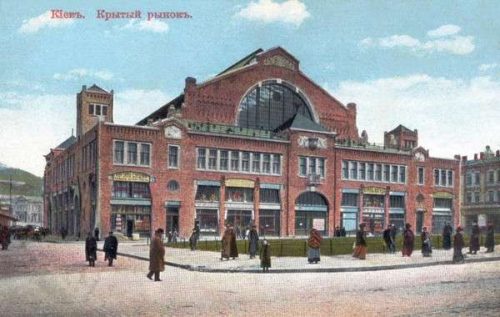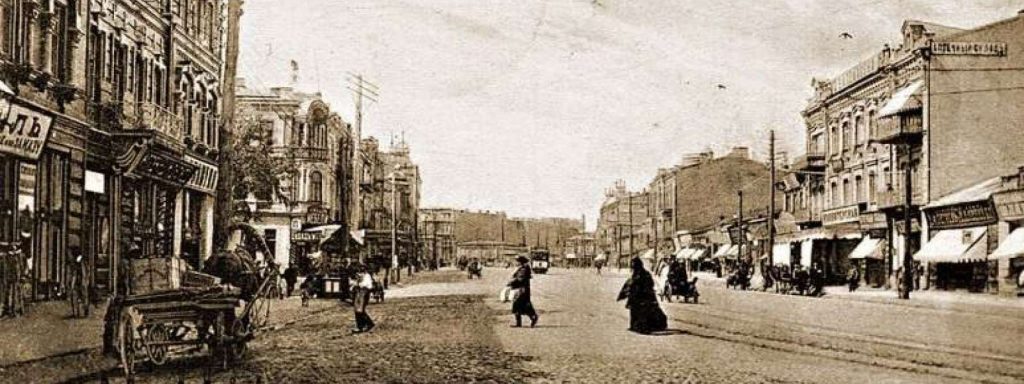"Laughter through Tears" in the era of Sholem Aleichem
Today we are talking with Oleksandra Uralova, the philologist and translator of Tevye the Dairyman, about Kyiv/Yehupets, the man who “lives on air,” and the era of Sholem Aleichem.
Sholem Aleichem lived in an era that has long since passed but whose traces we can still see in Kyiv and other Ukrainian cities. His texts are a kind of snapshot of trends that were characteristic of the turn of the [nineteenth] century. For example, the world of Tevye the Dairyman is not isolated. Historical events, like the Russo–Japanese War or the pogroms that took place in the fall of 1905, had an impact on Aleichem’s heroes and plots. It was precisely during this period that a number of Jews began moving into large cities in order to start their own businesses. Sholem Aleichem’s characters have similar plans.
We discuss the life of Sholem Aleichem and his heroes with Oleksandra Uralova, who is a tour guide, a scholarly associate of the Center for Studies of the History and Culture of East European Jews at Kyiv Mohyla Academy, as well as the translator of Tevye the Dairyman.
Andriy Kobalia: Let’s start with Sholem Aleichem’s biography and the parallels with his characters. We know that he was born in the second half of the nineteenth century and died in New York City in 1916. He lived during the last decades of the old era that ended with the First World War. Do Aleichem’s characters resemble him?
Oleksandra Uralova: Of course, they are similar. For starters, I will explain to our listeners that Sholem Aleichem is not a name but a signature that means “Peace unto you” in Hebrew and Yiddish. Solomon Nohumovich Rabinovich had a very keen eye and hearing attuned to daily life. He began to write in Russian at 14. He wrote a very long essay on the topic of his stepmother’s curses. This was the starting point of his realistic approach. But as he matured, he became more critical and—perhaps I may be exaggerating here—a certain magical realism was inherent in him, because these were works that were written by a person who was studying to become a crown rabbi; a person who had a good knowledge of Jewish life and folklore. Of course, a normal realist cannot be a magical realist.
The works of Sholem Aleichem that are most familiar to Ukrainian readers are Tevye the Dairyman, who is known from the play Tevye Tevel, with Bohdan Stupka in the starring role, at the Franko Theater. To what degree were his characters connected with his life? They were very connected. I would even say that Sholem Aleichem is a prototype. He is a “close relative”; some 27-year-old [male] relative on Tevye’s wife’s side, Menachem Mendl, about whom two books have even been written: The Letters of Menahem Mendl to His Wife Sheyne Sheyndl and New Letters. The author himself says that Menahem Mendl is a real person. He spent many years with the author, wandering through many cities. And those adventures that happened to Mendl in Odesa, Kyiv, or New York have a real underpinning. In his letters, he appears as a man “living on air” [luftmensch: An impractical person who literally lives on air—Trans.], who sells who knows what; someone along the lines of a proto-hipster. After some kind of start, he got into some sort of business, he began trading “London,” but he himself does not know what it is. The story begins this way, and for many years Mendl leaves his wife and attempts to engage in entrepreneurship.
The stories describing how Mendl arrives in Kyiv and tries to live there without a residence permit are taken from the life of Sholem Aleichem. During his first trips he was an illegal there.

Andriy Kobalia: I think that now would be a good time to explain why a residence permit was required to live in Kyiv in those days.
Oleksandra Uralova: In the late eighteenth century there were many lands in the Russian Empire out of which the Pale of Settlement, where Jews were allowed to live, was formed. First and foremost, these were the Ukrainian, Belarusian, and Lithuanian lands. The Pale of Settlement was comprised of these lands, for the most part Ukrainian lands. This was absolutely a losing proposition. The Russian government had several reasons for creating the Pale of Settlement. The first was economic. It was believed that “evil and bad Jews” were preventing Christian merchants from trading, claiming that because of this the economy of the empire had worsened. It was not at all because the people who until recently had been subjects of the Polish state suddenly found themselves in occupied lands.
The second reason was that part of the Jewish population supported the Polish uprisings. It was necessary to restrict the territories in which Jews could live. The Jewish population was forbidden to live in large cities and small villages. Only small towns remained. And this limited the sphere of employment. During Polish rule, Jews were given jobs that were “unworthy of a Christian,” for example, issuing loans. On the territory of the Russian Empire everything was even more specific. However, this did not take place in a day or even a year.
There was a long-standing and large Jewish community in Kyiv. The Jews of Kyiv were told for several years in a row that they had to sell off all their property and leave. However, the Jewish community of Kyiv was powerful. And this great struggle for existence took place throughout the entire nineteenth century. There was the “meat and candle tax” for the right to have a kosher butcher. A large proportion of the tax went for the upkeep of the police, which carried out rough searches aimed at finding illegal Jews. In other words, they engaged in persecuting they Jews, who were paying them.
And then Sholem Aleichem arrives—without a residence permit. Prior to this, the pogrom of 1881 takes place. And the old Kyiv Jewish community was not prepared for it. The pogrom was not simply a case of people simply looting and smashing glass. No, this was a real infliction of traumas, sometimes traumas that were incompatible with life. This was not the most terrible anti-Jewish pogrom, because the most terrible one happens later. And Sholem Aleichem will witness it. The Kyiv pogroms made a strong impact on him as well as on a Jewish woman from Kyiv, the fourth prime minister of Israel, Golda Meir. Her family left Kyiv precisely because of the pogroms. Sholem Aleichem’s family did the same thing in 1905.
This inter-pogrom period between 1881 and 1905 are the years when the writer lives frequently in Kyiv. He rents an apartment here, and his wife owns a dental office on Velyka Vasylkivska. It was an interesting city. Jews could not live there, but there was quite a large Jewish community.
Andriy Kobalia: What does Kyiv look like in Sholem Aleichem’s texts and why isn’t it called Kyiv in them?
Oleksandra Uralova: I think that this is generally quite a broad trend for realists at the turn of the [nineteenth] century. There is another writer who lived in the city at approximately the same time. And he called it the “City.” I am talking about Mikhail Bulgakov and his White Guard. Mendele Moykher-Sforim, who created quaint odd names for existing towns and cities, probably made the greatest impact on Sholem Aleichem; for example, “Glupsk.” We all know which city is meant here, but no one seems to know if this is a real city on a map. Yehupets is Egypt. Why Egypt? Probably because of the many indignities that Solomon Nohumovich experienced. As someone who was educated in Jewish classical scholarship, he could not avoid using this phrase, “We were slaves in the land of Egypt.” It is no wonder that he came up with this name. This is a city-state, a state within a state.
Kyiv has very many Christian toponyms based on biblical themes. We have a local Palestine—this is Khreshchatyi Yar [The Cruciform Ravine]; there is Mount Golgotha—this is Volodymyr Park, where the “Golgotha” panorama stood, which, I think, was erected at the turn of the [nineteenth] century. There is an area in the Lukianivka neighborhood called Yordan [Jordan]. It should be noted that the history of Tevye and Menachen Mendl’s family is connected not only to Kyiv or Odesa. There is also Berdychiv, which is called Kasarylivka in the text. In Mendl’s city, Kasarylivka, there is an electric streetcar; after all, Berdychiv was quite a developed town during this period. The first post of the trans-Eurasian telegraph in all the Ukrainian territories was set there.

Andriy Kobalia: And this considering that in the majority of Ukrainian cities during this period there were no paved streets, or streetcars, or telegraph.
Oleksandra Uralova: Kyiv is a very strange city. It’s not a port, like Odesa, but it’s the third-largest city in the empire, and the first in terms of technical achievements. That’s why Kyiv figured in his texts.
Andriy Kobalia: There are classic translations of Tevye the Dairyman, for example, in Russian. There are Ukrainian translations. And the last part in the text, which is connected with the pogroms of 1905, is missing in many of these translations. Why?
Oleksandra Uralova: There are eight chapters in Tevye the Dairyman. The last one is called “The Dark and Slippery Road.” Again, this is a quotation from the Old Testament. This is a strange chapter written in a reportorial style, and it differs from all the preceding ones. This happened because the author wrote it in the last year of his life. It was a difficult year because he was cheated by his colleagues from New York who had organized literary evenings for him. His oldest son had been killed; and he had tuberculosis. With all this happening, he had to delve into his most painful memories.
He survived the pogrom of 1905 in Kyiv. This was a terrible pogrom with hundreds of victims. Right now, we are marking the centenary of the 1917 revolutions, but there was another one—1905. And it was a long time coming. The revolution began with the Russo–Japanese War, the terrible life of the workers, the oppressed national minorities in the empire, with the very moderate—from today’s standpoint—but very left-wing movements for the time. And the Bund was formed within the Jewish milieu. There were attempts to communicate with the government, at first peacefully then not peacefully. Finally, after the brutal suppression of public rallies, Nicholas II issues a manifesto guaranteeing freedom of assembly, expression, etc. And the reaction to this was that regiments of Black Hundreds begin to batter the Jews. The tsar supposedly allowed them to rampage for three days. And in the last few moments, when it was still possible to hide, Sholem Aleichem hides in the hotel at the intersection of Rohnidynska and Velyka Vasylkivska streets. He saw people whom he did not know being killed. He manages to flee abroad. He loved Kyiv a lot and didn’t like New York because he did not have any business sense, and he was cheated there.
So, this is the kind of burden that he decides to write into the final chapter. That is why this chapter is reportorial, angry, and painful. Why was it not translated? It was translated. A multivolume edition came out in Shambadal’s translation, and it didn’t include the last chapter. It was circulated the samizdat [underground—Ed.] way. And it was circulated within the Russian-speaking population of Israel. A Ukrainian translation of the first seven chapters was published in the 1930s, and then they were simply republished. The last, eighth, chapter directs many accusations against the government, the middle classes, and the pogromists. In general, the question of the pogroms is raised clearly. It describes how Tevye avoided the pogrom. He simply chatted up his pogromist neighbors. He declares bitterly that “surely, we Jews are better than everyone because everyone is so jealous of us and wants to kill us.” This was not said with pride. When the translation came out in the 1930s, this could no longer be said.

Andriy Kobalia: Tevye the Dairyman was written in Yiddish. Hebrew was considered a high language, and Yiddish—a more popular one.
Oleksandra Uralova: They have their own names: “sacred”—that’s Hebrew, and “mama’s”—that’s Yiddish.
Andriy Kobalia: But what’s interesting is that Sholem Aleichem began writing in Russian. Why did he switch?
Oleksandra Uralova: This is not strange, considering that this is the end of the nineteenth century, and the beginning of self-awareness on the part of educated individuals as the leaders of their people. Today this sounds very naïve. This was the age of great empires, colonies, and “small nations.” The simplest way to unite these people is around language; a language that describes things that are comprehensible to everyone. Sholem Aleichem wrote not just about Tevye and Mendl. There was a period when he believed that he might become a leader. That is how the novel Stempenyu is written. His heroes are of the people: bootmakers, violinists, children. This is something that can be recognized. We can look at Ukrainian literature at the end of the nineteenth century, and see that there are popular heroes who were familiar to Ukrainians.
He began with the Russian language. I do think that Russian was the language spoken at home. He himself translated some of his stories into Russian, and some into English. Incidentally, in order to simplify the text and make it accessible to a wider circle of readers, he himself removed excerpts that were overloaded with religiosity. But this is preserved in the new translation. I believe that the culture of another people must be recounted as accurately as possible.
Andriy Kobalia: To what genre do Sholem Aleichem’s texts belong? He often describes bad, traumatic, or negative things, but there is also room for humor there. In his works are poor heroes with a pack of problems. Tevye’s life is tragic. So, are these generally tragic or comic texts?
Oleksandra Uralova: In general, the author himself identified the genre as “laughter through tears.” And this fits the turn of the century completely. Let’s look at Ukrainian comedies. Are they jolly? They are funny, but heavy and sad, and they are about something awful. If someone is having a really tough time, s/he’s not going to be lamenting all the time; s/he will be talking about tears through something that is funny. And that’s precisely when catharsis will take place.
This program was made possible by the Canadian non-profit organization Ukrainian Jewish Encounter.
Originally appeared in Ukrainian (Hromadske Radio podcast) here.
Translated from the Ukrainian by Marta D. Olynyk.
Edited by Peter Bejger.
NOTE: UJE does not necessarily endorse opinions expressed in articles and other materials published on its website and social media pages. Such materials are posted to promote discussion related to Ukrainian-Jewish interactions and relations. The website and social media pages will be places of information that reflect varied viewpoints.




















